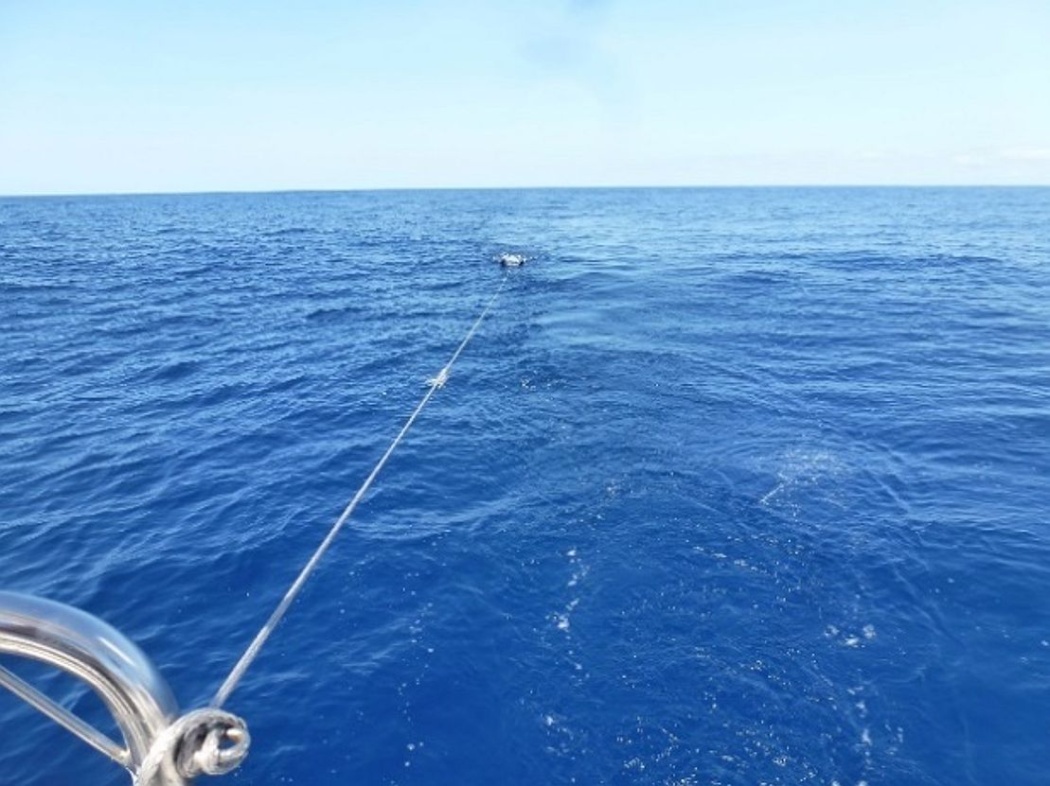The BEAGLE Microplastics North Atlantic Project: Sampling and approach
Sampling and treatment on board
The sampling was conducted on board the sailing boat Beagle with oceanic surface water. During a first trial, samples were collected using a microplastic net with a 300 µm mesh size and 70 x 40 cm mouth
For detailed information on specifications of of net and the sampling measures and approach please have a look into the BEAGLE report via this link or on the Cover Page.

Modified Neuston microplastic net on the aft deck of the BEAGLE (Photo by Ulrich & Alice Zenneck)
The net was modified with two fenders so that the upper edge was at the same level as the ocean surface, and it was fixed with four ropes. Samples could only be collected at a Beaufort scale ≤ 3. A particularly high wave destroyed the MP net’s suspension, and it was lost.
These initial test samples were treated on board with ca. 50 mL of a 10 M potassium hydroxide (KOH) solution for 84 h at 30 – 40 °C to decompose most of the organic matter. The mixture was then neutralized with 28 g citric acid in 100 mL H2O at room temperature. Only a fraction of the fish eggs and shrimp shells could be dissolved. Therefore, and to avoid further loss of sample material, the samples taken after this test phase were treated in the laboratory.

Modified MP net with 20 x 30 cm opening, aluminum frame, and fenders, suspended with stainless-steel ropes connected to a rope (Photo by Ulrich & Alice Zenneck)
In total, ten samples (S6 – S15) were collected during a trip from the Caribbean to the British Isles in April to June of 2023 using a similarly modified net with a smaller 30 x 20 cm opening which was secured with stainless-steel ropes (photo on right).
With the updated system, samples could be collected at a Beaufort scale ≤ 4. To eliminate the influence of oceanic currents, the ship was kept at steady speeds between one and five knots. The speed measurement inaccuracy was 5 %. Across all ten samples an average distance of 1.3 ± 0.5 km (1 SD, n = 10, range 0.74 – 1.85 km) was covered per sample, equivalent to an average water volume of (8 ± 3) x 10 m3 (1 SD, n = 10, range 45 – 111 m3). Still on board, macroscopic flora, fauna, and plastics were sorted out and the residual components of the samples were rinsed from the MP net onto a 300 μm mesh filter and subsequently transferred to polyethylene (PE) bags.
Sampling route

Mitigating contamination
Due to their omnipresence, mitigating procedural sample contamination is of high im-portance in MP analysis. The contamination with natural microparticles should be avoided as well, as they prolong the sample preparation and final measurements and can interfere with the analysis by infrared spectroscopy.
On board the Beagle, wearing clothing made of polar fleece and other synthetic fibers was avoided during sampling. In the laboratory, all clothing was made almost exclusively from cotton and wearing nail polish as well as plastic hand jewelry was avoided. Nitrile butadiene rubber gloves were worn only when handling corrosive chemicals. All the laboratory equipment was made of glass and/or stainless steel. All tools for which plastics could not be avoided were made from perfluorinated polymers. Prior to use, all instruments were thoroughly washed with ultrapure water as well as ≥ 99.8 % ethanol that was previously filtered over 0.4 µm polycarbonate (PC) track-etched membrane filters.




